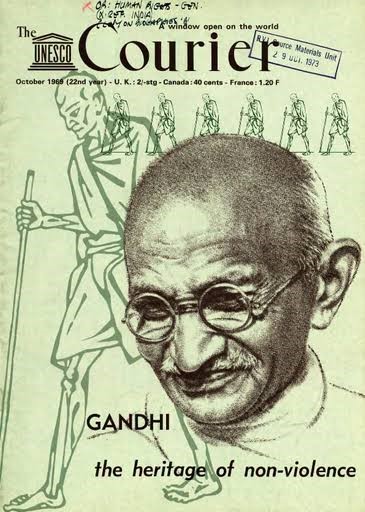The Ahiṃsā Vrata of Satyagraha:
Gandhi sought to take recourse in the most powerful natural and spiritual principle that exists and is readily available to humanity: nonviolence, or ahiṃsā. For Gandhi, “Nonviolence is the greatest force at the disposal of mankind. It is mightier than the mightiest weapon of destruction devised by the ingenuity of man. Destruction is not the law of the humans.”3 Thus, following a strategy of nonviolence provides the greatest hope of victory.
But, for Gandhi, ahiṃsā was also a necessary means for spiritual development. Ahiṃsā is irrevocably related to the karma theory embraced by Jains and others. The course of social change and spiritual development coincide with the dictates of nonviolence such that one must never retaliate. For Gandhi, “Man lives freely by his readiness to die, if need be, at the hands of his brother, never by killing him. Every murder or other injury, no matter for what cause, committed or inflicted on another is a crime against humanity.”4 A Satyagrahi must not seek to “punish” those who we think “harass us” because that only creates “another victim” leading to a “vicious circle.” Rather, “it is better to endure the thieves than to punish them” especially since such “forbearance may even bring them to their senses”5 when through our willingness to suffer without retaliation we expose our deepest spiritual nature to be witnessed by the perpetrator, inspiring their own spiritual, and thus social, transformation.
The Aparigraha Vrata of Satyagraha:
For Gandhi, there were also social implications for the dharmic principle of aparigraha, “non-consumption,” or “non-possession,” one of the “three A’s” of Jain Dharma. Gandhi, like Jains, saw a relationship between violence and possession/consumption. All consumption involves violence and the accretion of negative karma because somewhere on any supply chain violence has been committed in the production of any product, and conversely, non-consumption/non-possession removes karma. For Gandhi “[l]ove and exclusive possession can never go together…when there is perfect love, there must be perfect non-possession.” For extremely advanced Jain mendicants this implies eventually abstaining from all food, water, movement, and even breath, practicing the withdrawal of life from our last possession, our body, in the process of saṃlekhanā. For Gandhi nonviolence likewise implies a sacrifice of our bodies, but this sacrifice can be made in service of a social cause. For him, “[t]he body is our last possession” and to “exercise perfect love and be completely dispossessed” one must be “prepared to embrace death and renounce his body for the sake of human service.”6
Gandhi Practiced Anekānta-vāda as Interfaith Identity :
Gandhi, much like many Jains today, employed anekānta-vāda as a sort of “intellectual ahiṃsā” because it allowed him to move from a position of resentment for “the ignorance of my opponents” to a position such that he can allow the “whole world in the embrace of my love.” For him “Anekantavad is the result of the twin doctrine of Satyagraha and Ahimsa.” Thus, by invoking Anekānta-vāda, Gandhi accepted the seemingly contradictory positions of multiple.
Religions based on the Jain “doctrine of the manyness of reality” that he derived “[f]rom the platform of the Jains…” Anekānta-vāda leads him to the harmonious conclusion that “we are all thinking of the Unthinkable, describing the Indescribable, seeking to know the Unknown, and that is why our speech falters, is inadequate, and even often contradictory.”7 For Gandhi, this conciliatory approach to religious pluralism embodied by Jain anekānta-vāda was essential to quell interreligious violence and to allowing one to broaden the scope of one’s religious inquiry to realize the “fundamental truth of all great religions of the world.”8
Reference notes:
1Gandhi 1967, 34-35, Young India, 3-11’27.
2Gandhi 1993, 39.
3Gandhi 1972, 77, Harijan, July 20, 1931.
4Gandhi 1972, 77, Harijan, July 20, 1931.
5Gandhi 1967, 41, From Yeravda Mandir, chapters I to III and IV.
6Gandhi 1972, 118, Modern Review, October 1935.
7Gandhi 2015, 13-14, Young India, 21-1-’26.
8Gandhi 2015, 55; Harijan, February 16, 1934.
Bibliography:
Gandhi, M.K. 2015. Truth is God. Gleanings From the Writings of Mahatma Gandhi Bearing on God, God Realization, and the Godly Way. Kindle Edition. Prabhat Prakashan Publishers.
- Non-Violent Resistance (Satyagraha). Kindle Edition. Mineola, New York: Dover Publication.
- Gandhi, An Autobiography: The story of My Experiments with Truth. Boston: Beacon Press.
- All Men Are Brothers. Published by the United Nations Educational, Scientific and Cultural Organization. New York: Columbia University Press.
- Non-Violent Resistance. Ahmedabad: Navajivan Trust.





Fabulous collection of information to read about Gandhiji
Fantastic site A lot of helpful info here Im sending it to some buddies ans additionally sharing in delicious And naturally thanks on your sweat
of course like your website but you have to check the spelling on several of your posts A number of them are rife with spelling issues and I in finding it very troublesome to inform the reality on the other hand I will certainly come back again
I liked it as much as you did. Even though the picture and writing are good, you’re looking forward to what comes next. If you defend this walk, it will be pretty much the same every time.
Because the site’s administrator is actively working, its reputation will undoubtedly grow rapidly as a result of its excellent material.
Attractive section of content I just stumbled upon your blog and in accession capital to assert that I get actually enjoyed account your blog posts Anyway I will be subscribing to your augment and even I achievement you access consistently fast
Just wish to say your article is as surprising. The clearness in your post is just cool and i could assume you’re an expert on this subject. Fine with your permission allow me to grab your RSS feed to keep updated with forthcoming post. Thanks a million and please keep up the enjoyable work.
certainly like your website but you need to take a look at the spelling on quite a few of your posts. Many of them are rife with spelling problems and I find it very troublesome to inform the reality nevertheless I will definitely come back again.
I do believe all the ideas you’ve presented for your post. They are really convincing and will certainly work. Nonetheless, the posts are too short for novices. May just you please lengthen them a little from subsequent time? Thanks for the post.
Your article helped me a lot, is there any more related content? Thanks!